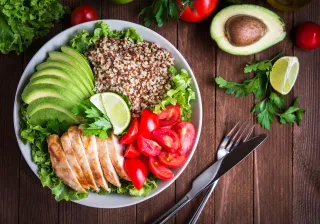Finland strives for carbon neutrality by 2035. The reform of the food production system, particularly the introduction of new food production methods, would bring Finland closer to the goal. This could also improve Finland's protein self-sufficiency, which is increasingly important in the current geopolitical situation. However, the report by VTT Technical Research Centre of Finland and Natural Resources Institute Finland (Luke) shows that the introduction of new methods requires actions on many fronts. Funding, regulations, and competence development play a key role.
The Food without Fields project, coordinated by VTT, examined the possibilities and challenges of new food production methods in Finland. These methods included cellular agriculture, i.e. harnessing microbes and plant cells to produce feed and food, as well as the production of new protein-rich crops under controlled conditions, such as in greenhouses and vertical farming environments.
With these new methods and renewable energy, food could be produced with less emissions. Agricultural land use could be reduced by over 90%, which would free up land for carbon sequestration by other means. Protein self-sufficiency would improve and feed production in fields and the need for fertilisers would decrease. Furthermore, with the new methods, Finland could see new plant species cultivated here, and food could be produced regardless of weather conditions and seasons. All this would open new business opportunities.
"The enormous potential of new food production methods has not been fully recognised in Finland. Change does not just happen; it requires action. Funding, which must continue seamlessly from the development of methods, to piloting and increasing production scale, is essential. Funding is needed both for research and for companies' investments; seed funding is not enough for the construction of plants and vertical farming systems in Finland, in this scale,” says project leader Emilia Nordlund from VTT.
The support instruments, legislation, and competence to be reformed
Alongside funding, the financial aid for food production requires altering. For example, cellular agriculture is currently in a grey area and is not covered by farming subsidies. Investment subsidies, in particular, should be directed at sustainable food solutions that renew the food production.
Europe has a stricter novel foods legislation than the United States or Asia, which also poses various challenges. For instance, the Novel Food regulation slows down the entry of cellular agriculture products into the market. The current GMO legislation on gene technologies obstructs both innovations in cellular agriculture and the development of new and more sustainable plant varieties. Legislation changes slowly, but demanding and slow permit processes can be facilitated by increasing advice for and cooperation with food system actors, in order to increase the exchange of information, for example.
The introduction of new methods also requires new types of competence. The source of the future experts is yet unknown: will primary producers be responsible for the operation of new food production plants or is the competence found elsewhere? Whatever the solution, more education is needed in the sector.
The change will also impact entire value chains. There will be new partnerships, in which the side streams of one plant will produce raw materials for others. We must work out how the value chain should be developed, as a whole. This includes, for example, the question of how centralised the food production is. "The current production system is highly centralised, and supply chains often run from one continent to another. With the new methods, we could move towards a more decentralised system and more local chains,“ Nordlund envisions.
Consumer attitudes are crucial
When reforming food production methods, we must not forget about the consumers – change only happens if the consumers accept it. That is why we need to invest in confidence-building consumer communication. Fact based information about new products, for example the ones produced by cellular agriculture, will dispel concerns, and create prerequisites for food products produced using new methods, to succeed in the market.
The Food without Fields project is part of the Ministry of Agriculture and Forestry's Catch the Carbon research and innovation programme, which supports climate-sustainable land use solutions. The study carried out in the project was implemented with the help of an online survey, and a workshop, as well as the project expert group.
For more information:
Emilia Nordlund
Research Manager, Project Leader, VTT
+358 40 504 2963
[email protected]
Jarkko Niemi
Research Professor, Luke
+358 29 532 6392
[email protected]





